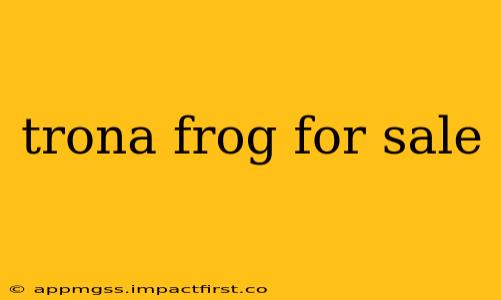The vibrant, miniature world of Trona frogs (also known as Pseudacris triseriata or the striped chorus frog) captivates many herpetology enthusiasts. While you won't find them readily available for sale in the same way you might find common pet store animals, understanding their habitat, needs, and legal considerations is crucial before considering acquiring one. This guide will address the common questions surrounding Trona frogs and their care, providing a comprehensive overview for prospective keepers.
Where Can I Buy a Trona Frog?
Finding Trona frogs for sale is challenging. They are not typically bred commercially for the pet trade, unlike some other frog species. Therefore, acquiring one usually involves more specialized routes. Ethical sources might include licensed breeders involved in conservation or rescue organizations specializing in amphibians. Purchasing from reputable sources is vital to ensure the frog's health and well-being and to support responsible practices. Remember to always verify permits and legality before acquiring any wildlife.
Are Trona Frogs Legal to Own?
The legality of owning a Trona frog varies significantly depending on your location. Many jurisdictions have regulations concerning the possession of native wildlife, and Trona frogs are typically protected under these laws. Before even considering purchasing a Trona frog, thoroughly research the specific regulations in your state, province, or country. Failure to comply with these laws can result in serious penalties. Always obtain necessary permits and licenses before acquiring any protected species.
What Do Trona Frogs Need in Captivity?
Housing a Trona frog successfully requires a deep understanding of its natural habitat. Creating a naturalistic environment is paramount to their well-being. Key aspects include:
- Appropriate Enclosure: A terrarium with adequate ventilation is crucial. The size should be appropriate for the frog's size, allowing ample space to hop and explore.
- Substrate: A moist substrate mimicking their natural environment, such as a blend of peat moss and coconut fiber, provides ideal humidity levels.
- Temperature and Humidity: Maintaining appropriate temperature and humidity levels is critical. Research the specific temperature and humidity ranges for Trona frogs in their native habitat to accurately replicate these conditions.
- Lighting: While not needing intense lighting, providing a gentle light cycle that mimics natural daylight hours is beneficial.
- Water Source: A shallow dish of clean water should always be available. The water should be changed regularly to maintain hygiene and prevent bacterial growth.
- Hides: Providing hiding places, such as rocks, driftwood, or artificial shelters, offers security and reduces stress.
- Food: Trona frogs primarily feed on insects, including crickets, small flies, and other appropriate prey items. Supplementing their diet with appropriate vitamins and minerals is essential for their health.
How Much Does a Trona Frog Cost?
Because of their rarity in the pet trade, the cost of a Trona frog can be variable and potentially high if sourced ethically through a licensed breeder or rescue. The price will depend on several factors, including the frog's age, health, and the breeder's reputation. The cost of setting up and maintaining the necessary terrarium environment should also be factored into the overall expense.
Conclusion: Responsible Ownership
Owning a Trona frog presents unique challenges and rewards. Prioritizing ethical sourcing, understanding legal requirements, and creating a suitable environment are crucial for the frog's well-being and longevity. Responsible ownership ensures the preservation of this fascinating species while allowing enthusiasts to appreciate its natural beauty. Remember that responsible amphibian keeping requires research, commitment, and a deep respect for the animal's needs.
